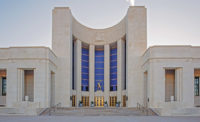The Sazerac House
New Orleans
Best Project, Renovation/Restoration
Project of the Year
Key Players
Owner: Sazerac Louisiana Holdings LLC
Lead Design Firm: Trapolin-Peer Architects
General Contractor: Ryan Gootee General Contractors LLC
Structural Engineer: Morphy Makofsky Inc.
MEP Engineer: Moses Engineers
The $45-million restoration that gave life to the Sazerac House entailed as many layers of history, complexity and New Orleans flavor as the cocktails to which it pays homage.
The project team was tasked with rehabilitating two 1860s-era buildings at one of the city’s most prominent downtown intersections—Canal and Magazine streets —to create a six-story attraction serving multiple functions under one roof. The nearly 52,000-sq-ft Sazerac House consists of an interactive cocktail museum, operating micro-distillery, event venue and corporate headquarters for the Sazerac Co., the spirits company behind the project.
“The fact that each of these facets of the project were the responsibility of three different design firms contracted directly with the owner only adds to the challenge,” says David Barbier, vice president of preconstruction for Ryan Gootee General Contractors LLC. Trapolin Peer Architects oversaw the building renovation and restoration, Gallagher & Associates handled the exhibit design and Vendome Copper designed the distillery.
Structural Difficulty
Crews had to iron out numerous structural issues before construction could begin. Time, the elements and overall neglect had taken a toll on the historic buildings, which had sat vacant and deteriorating for three decades.
Initial inspections revealed extensive damage from termites and long-standing roof leaks. During Hurricane Katrina, storm-force winds lifted the roof, which had been held in place only by gravity, and caused the collapse of support columns. The exterior walls had settled significantly—between 2 in. and 11.5 in. throughout the building.
“There were entire floors of the building we could not even walk on to get initial dimensions,” says Shea Trahan, associate with Trapolin Peer Architects. A 3D scan of the buildings provided a better sense of where walls and floors needed to be stabilized.
The real surprise was when crews discovered just how badly the existing load-bearing masonry walls had deteriorated. “Not only were masonry walls separating, but the existing mortar was crumbling and loose,” Barbier says.
Crews injected specially formulated grout into the masonry walls to stabilize them and then core-drilled holes, inserted sleeves and grouted rods to bind the masonry.
Once the building was stabilized, crews were able to begin the process of renovating and restoring the building. The team used 3D modeling to coordinate the infrastructure and navigate the design, fabrication and installation of the mechanical and electrical systems.
“The proverbial ‘How do you pack 10 pounds of sausage in a 5-pound casing?’ is what comes to mind when thinking about how the mechanical and electrical systems were concealed in the building,” Barbier says.
The team created vertical shafts out of abandoned light wells and built mechanical wells in historic pitched roofs to fit in mechanical ductwork, piping, electrical conduit and low-voltage raceways.
Past, Present and Future
Historic restoration and sustainability features were prominent in the Sazerac House, giving a nod to the past while planning for the future.
Salvaged elements and historic photos helped the project team preserve and recreate the buildings’ original details, many of which had been lost in multiple renovations over the years.
“This project was very reliant on architectural archaeology, and because of these found elements, we could restore much of the building’s original grandeur with confidence in the accuracy of the restoration,” Trahan says.
By pulling back layers of the buildings, the team was able to repair, replicate and replace hundreds of windows, doors, stairs and exterior storefront doors.
Sustainability was another objective, and to meet the city’s stormwater retention requirements, the project team installed two underground tanks to store water from the building’s roof. The tanks were installed in sections to avoid conflicts with existing foundations.
The team also lowered carbon emissions by 2,557 metric tons and kept 5,334 tons of material out of landfills.
Eye Openers
Creating visual appeal was essential to the design. The showpiece of the Sazerac House is a three-story bottle display wall and monumental staircase. The 46-ft tall, glass-encased display wall showcases more than 2,000 liquor bottles and serves as a backdrop for the staircase.
Restoring the building’s curved historical staircase was a delicate operation because the entire structure was collapsing and sagging. “The stair was in such bad shape that we were only able to salvage enough material to restore it from floors one through three,” Trahan says.
The project team conducted a 3D scan of the staircase and then took it apart, piece by piece. Master carpenters carefully catalogued each salvaged piece, then recreated the staircase in their warehouse before finally installing it in the building.
To accommodate the bottle wall, the project team carved an opening through the building’s existing floors, restructuring the adjacent floor areas along the way. The bottle wall was engineered on an isolated foundation that could hold the weight of 46 vertical ft of steel, wood and glass, plus hundreds of liquor bottles.
The distillery features another prominent visual element—a custom-designed, two-story copper still that is visible from Canal Street. The still contains a 500-gallon pot topped with a distilling column and a giant ice-storage tank that creates thousands of pounds of ice nightly. Crews had to lift an 11,000-lb chiller into place to build out the distillery.
Designing and constructing a fully functioning distillery called for special attention to safety, given the explosive materials housed in the distillery and its location immediately adjacent to a Canal Street sidewalk.
The design team compartmentalized the distillery area with additional fire and heat protection to separate the highly flammable alcohol production from other spaces. The project ended up exceeding fire-code requirements by including several concealed fire safety measures, including an early detection system that can identify potential fire risks and initiate evacuations several minutes before an emergency.
Connecting with the Community
Community involvement factored into the project, and Ryan Gootee General Contractors gave apprentices from unCommon Construction—a nonprofit apprenticeship program for high school students—an opportunity to visit the Sazerac House jobsite and interact with project executives.
Josh Bolds, one of the apprentices on the tour, was hired by Ryan Gootee as a summer intern after he graduated. “Building on the skills to be open and honest, ask questions and pitch in where needed helped build the confidence I needed to succeed,” Bolds says.
The contractor also worked with the city’s diversity office to hire companies that qualify as disadvantaged business enterprises (DBEs). By the project’s completion, the contractor had achieved an 18% DBE participation rate.
The project team completed the Sazerac House in June 2019 after two years of construction, and the attraction opened to the public in October.









